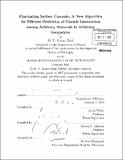| dc.contributor.advisor | Jacob White and Steven G. Johnson. | en_US |
| dc.contributor.author | Reid, M. T. (McMahon Thomas Homer) | en_US |
| dc.contributor.other | Massachusetts Institute of Technology. Dept. of Physics. | en_US |
| dc.date.accessioned | 2012-01-30T17:07:44Z | |
| dc.date.available | 2012-01-30T17:07:44Z | |
| dc.date.copyright | 2011 | en_US |
| dc.date.issued | 2011 | en_US |
| dc.identifier.uri | http://hdl.handle.net/1721.1/68983 | |
| dc.description | Thesis (Ph. D.)--Massachusetts Institute of Technology, Dept. of Physics, 2011. | en_US |
| dc.description | Cataloged from PDF version of thesis. | en_US |
| dc.description | Includes bibliographical references (p. 161-163). | en_US |
| dc.description.abstract | For most of its 60 year history, the Casimir effect was an obscure theoretical backwater, but technological advances over the past decade have promoted this curious manifestation of quantum and thermal fluctuations to a position of central importance in modern experimental physics. Dramatic progress in the measurement of Casimir forces since 1997 has created a demand for theoretical tools that can predict Casimir interactions in realistic experimental geometries and in materials with realistic frequency-dependent electrical properties. This work presents a new paradigm for efficient numerical computation of Casimir interactions. Our new technique, which we term the fluctuating-surface-current (FSC) approach to computational Casimir physics, borrows ideas from the boundary-element method of computational electromagnetism to express Casimir energies, forces, and torques between bodies of arbitrary shapes and materials in terms of interactions among effective electric and magnetic surface currents flowing on the surfaces of the objects. We demonstrate that the master equations of the FSC approach arise as logical consequences of either of two seemingly disparate Casimir paradigms-the stress-tensor approach and the path-integral (or scattering) approach-and this work thus achieves an unexpected unification of these two otherwise quite distinct theoretical frameworks. But a theoretical technique is only as relevant as its practical implementations are useful, and for this reason we present three distinct numerical implementations of the FSC formulae, each of which poses a series of unique technical challenges. Finally, using our new theoretical paradigm and our practical implementations of it, we obtain new predictions of Casimir interactions in a number of experimentally relevant geometric and material configurations that would be difficult or impossible to treat with any other existing Casimir method. | en_US |
| dc.description.statementofresponsibility | by M. T. Homer Reid. | en_US |
| dc.format.extent | 163 p. | en_US |
| dc.language.iso | eng | en_US |
| dc.publisher | Massachusetts Institute of Technology | en_US |
| dc.rights | M.I.T. theses are protected by
copyright. They may be viewed from this source for any purpose, but
reproduction or distribution in any format is prohibited without written
permission. See provided URL for inquiries about permission. | en_US |
| dc.rights.uri | http://dspace.mit.edu/handle/1721.1/7582 | en_US |
| dc.subject | Physics. | en_US |
| dc.title | Fluctuating surface currents : a new algorithm for efficient prediction of Casimir interactions among arbitrary materials in arbitrary geometries | en_US |
| dc.title.alternative | FSC : a new algorithm for efficient prediction of Casimir interactions among arbitrary materials in arbitrary geometries | en_US |
| dc.title.alternative | New algorithm for efficient prediction of Casimir interactions among arbitrary materials in arbitrary geometries | en_US |
| dc.type | Thesis | en_US |
| dc.description.degree | Ph.D. | en_US |
| dc.contributor.department | Massachusetts Institute of Technology. Department of Physics | |
| dc.identifier.oclc | 774034274 | en_US |
